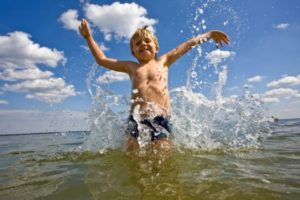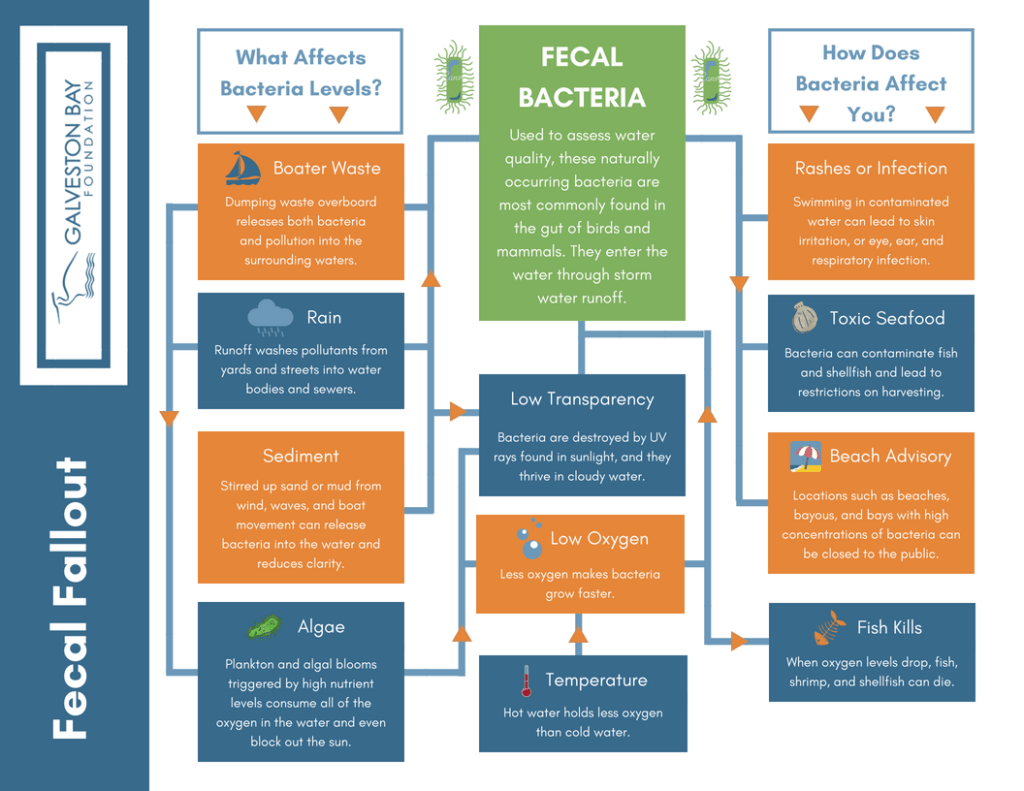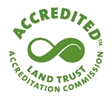Is Galveston Bay safe for swimming?
- July 02, 2021
- News

Summers in Texas get so hot, it’s no wonder that people choose to cool off in the water! From swimming and kayaking to sailing and fishing, Houston-Galveston Area residents flock to Galveston Bay frequently to enjoy a variety of water recreation activities. Many of these people reach out to Galveston Bay Foundation (GBF) to ask if the water is safe to swim in, and fortunately, we have the answer!
The main concern for swimming in any surface water is the presence of bacteria. Enterococcus bacteria are a valuable indicator for determining the presence of fecal contamination in recreational surface waters like Galveston Bay and are more resilient in saltwater than other indicators. These naturally occurring bacteria are found in the guts of birds and mammals, including humans. Exposure to fecal bacteria can cause sickness such as rashes and skin irritation, as well as eye, ear, and respiratory infections.
High bacteria levels can lead governmental agencies to issue beach advisories and restrict public access to beaches, bayous, or bays. Additionally, high concentrations of these bacteria and associated pathogens can accumulate in oysters and other shellfish, making them unsafe to eat, especially if eaten raw. Large areas of Galveston Bay are closed for harvesting shellfish for direct consumption due to elevated concentrations of bacteria.
GBF’s volunteer Water Monitoring Team collects monthly water quality data, including enterococcus bacteria concentrations, at multiple shoreline locations around the Bay. The most recent fecal bacteria concentrations for each location are recorded on GBF’s Water Quality Data Visualization Portal at waterdata.galvbay.org. These results are also uploaded to Swim Guide at theswimguide.org, which also shows concentrations throughout the United States.
Luckily, bacteria levels in Galveston Bay are usually safe for swimming. Read on to learn more!
What causes fecal bacteria to enter Galveston Bay?
There are typically spikes in bacteria concentrations following major rainfall events. This is due to runoff carrying bacteria into the Bay from a variety of land sources, such as failing septic systems, pet waste, and livestock. Luckily, anyone can help to reduce bacteria concentrations in their local watershed in two ways: by reducing sources of pollution at home and by reducing runoff from their property through more efficient lawn irrigation, use of rain barrels, or the installation of green infrastructure. Galveston Bay Foundation provides advice for local residents on how to improve water quality through the Galveston Bay Report Card, at galvbaygrade.org/what-you-can-do/.
Boats with toilets or heads on board also have the potential to contribute to bacteria contamination in Galveston Bay, because even “treated” waste has elevated concentrations of fecal bacteria. This is why it’s illegal to dump untreated waste in the Bay and to dump either treated or untreated waste into Clear Lake.
In the Bay Area, there are currently close to 9,000 registered recreational vessels with heads on board and an average of 821 commercial vessel transits taking place per day. That’s the potential for a lot of waste!
What factors influence bacteria growth in the environment?
Once these fecal bacteria have entered our waterways, the length of time they can survive can be impacted by several factors.
Bacteria are destroyed by the UV rays found in sunlight, so they thrive in cloudy or turbid water. Additionally, sand or mud that has been stirred up by wind, waves, or boater activity can reduce water clarity and directly release bacteria from the soil.
Bacteria also grow faster when there is less dissolved oxygen in the water. Low oxygen can occur when temperatures are high or when there is an algal bloom. Algae or plankton blooms are the result of high levels of nutrients in the water. When these blooms occur, much of the oxygen in the water is consumed and the water becomes cloudy. The first evidence of this occurring is often a fish kill, when small fish species die en masse. Perfect conditions for bacteria to grow in!
However, the biggest indicator of high bacteria levels is rainfall. Bacteria levels often spike after a storm, due to polluted runoff from our streets, lawns, and infrastructure malfunctions.
Infographic: Impacts on Fecal Bacteria

How do I know if it is safe to swim?
Before jumping into the water, check out the latest water quality report at waterdata.galvbay.org and the bacteria concentrations at theswimguide.org. Watch out for large amounts of algae floating in the water or dead wildlife in the area. If the water is very cloudy or if it recently stormed, think twice before swimming!
Luckily, our bacteria monitoring program has shown that most of the time bacteria levels in Galveston Bay are low enough to be considered safe for swimming.
If you are looking for bacteria advisories on the Gulf-Side instead of the Bay-Side, visit the Texas Beach Watch website at cgis.glo.texas.gov/Beachwatch/index.html.
What can I do to decrease bacteria in the Bay?
-
- Properly dispose of your used cooking fat, oil, and grease in order to prevent burst sewer pipes. Never let these items go down the drain, but rather throw them away in the trash or locate a recycling facility at ceasethegrease.net
- Pump out, don’t dump boater waste | pumpdontdump.org
- Reduce runoff by using a rain barrel | galvbay.org/rainbarrels
- Report pollution, including sewer overflows and discolored, smelly water using the Galveston Bay Action Network | galvbay.org/gban
- Check out other ways to reduce pollution and ensure the health of Galveston Bay at galvbaygrade.org/what-you-can-do/.
This article was originally written by Ted Driscoll in 2019. Updated 7/2/2021.




